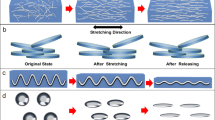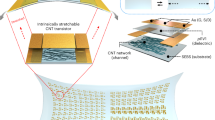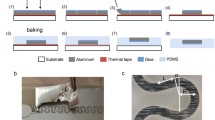Abstract
Stretchable electronics represents a direction of recent development in next-generation semiconductor devices. Such systems have the potential to offer the performance of conventional wafer-based technologies, but they can be stretched like a rubber band, twisted like a rope, bent over a pencil, and folded like a piece of paper. Isolating the active devices from strains associated with such deformations is an important aspect of design. One strategy involves the shielding of the electronics from deformation of the substrate through insertion of a compliant adhesive layer. This paper establishes a simple, analytical model and validates the results by the finite element method. The results show that a relatively thick, compliant adhesive is effective to reduce the strain in the electronics, as is a relatively short film.
Similar content being viewed by others
References
Rogers J.A., Huang Y.: A curvy, stretchy future for electronics. PNAS 106, 10875–10876 (2009)
Rogers J.A., Someya T., Huang Y.: Materials and mechanics for stretchable electronics. Science 327, 1603–1607 (2010)
Viventi J., Kim D.H., Moss J.D. et al.: A conformal, bio-interfaced class of silicon electronics for mapping cardiac electrophysiology. Sci. Transl. Med. 2, 24ra22 (2010)
Kim D.H., Viventi J., Amsden J.J. et al.: Dissolvable films of silk fibroin for ultrathin, conformal bio-integrated electronics. Nat. Mater. 9, 511–517 (2010)
Wagner S., Lacour S.P., Jones J. et al.: Electronic skin: architecture and components. Physica E 25, 326–334 (2005)
Ko H.C., Stoykovich M.P., Song J. et al.: A hemispherical electronic eye camera based on compressible silicon optoelectronics. Nature 454, 748–753 (2008)
Ko H.C., Shin G., Wang S. et al.: Curvilinear electronics formed using silicon membrane circuits and elastomeric transfer elements. Small 5, 2703–2709 (2009)
Shin G., Jung I., Malyarchuk V. et al.: Micromechanics and advanced designs for curved photodetector arrays in hemispherical electronic eye cameras. Small 6, 851–856 (2010)
Kim D.H., Ahn J.H, Choi W.M. et al.: Stretchable and foldable silicon integrated circuits. Science 320, 507–511 (2008)
Kim D.H., Choi W.M., Ahn J.H. et al.: Complementary metal oxide silicon integrated circuits incorporating monolithically integrated stretchable wavy interconnects. Appl. Phys. Lett. 93, 044102 (2008)
Kim D.H., Song J., Choi W.M. et al.: Materials and non-coplanar mesh designs for integrated circuits with linear elastic responses to extreme mechanical deformations. PNAS 105, 18675–18680 (2008)
Kim D.H., Liu Z., Kim Y.S. et al.: Optimized structural designs for stretchable silicon integrated circuits. Small 5, 2841–2847 (2009)
Yoon J., Baca A.J., Park S.I. et al.: Ultrathin silicon solar microcells for semitransparent, mechanically flexible and microconcentrator module designs. Nat. Mater. 7, 907–915 (2008)
Baca A.J., Yu K.J., Xiao J. et al.: Compact monocrystalline silicon solar modules with high voltage outputs and mechanically flexible designs. Energy Environ. Sci. 3, 208–211 (2010)
Park S.L., Xiong Y., Kim R.H. et al.: Printed assemblies of inorganic light-emitting diodes for deformable and semitransparent displays. Science 325, 977–981 (2009)
Park S.I., Le A.P., Wu J. et al.: Light emission characteristics and mechanics of foldable inorganic light-emitting diodes. Adv. Mater. 22, 3062–3066 (2010)
Huang Y., Zhou W., Hsia K.J. et al.: Stamp collapse in soft lithography. Langmuir 21, 8058–8068 (2005)
Hsia K.J., Huang Y., Menard E. et al.: Collapse of stamps for soft lithography due to interfacial adhesion. Appl. Phys. Lett. 86, 154106 (2005)
Zhou W., Huang Y., Menard E. et al.: Mechanism for stamp collapse in soft lithography. Appl. Phys. Lett. 87, 251925 (2005)
Meitl M.A., Zhu Z.T., Kumar V. et al.: Transfer printing by kinetic control of adhesion to an elastomeric stamp. Nat. Mater. 5, 33–38 (2006)
Meitl M.A., Feng X., Dong J. et al.: Stress focusing for controlled fracture in microelectromechanical systems. Appl. Phys. Lett. 90, 083110 (2007)
Feng X., Meitl M.A., Bowen A.M. et al.: Competing fracture in kinetically controlled transfer printing. Langmuir 23, 12555–12560 (2007)
Kim T.H., Carlson A., Ahn J.H. et al.: Kinetically controlled, adhesiveless transfer printing using microstructured stamps. Appl. Phys. Lett. 94, 113502 (2009)
Kim, S., Wu, J., Carlson, A., et al.: Microstructured elastomeric surfaces with reversible adhesion and examples of their use in deterministic assembly by transfer printing. PNAS. 107, 17095–17100 (2010)
Kim D.H., Kim Y.S., Wu J. et al.: Ultrathin silicon circuits with strain-isolation layers and mesh layouts for high-performance electronics on fabric, vinyl, leather, and paper. Adv. Mater. 21, 3703–3707 (2009)
Khang D.Y., Jiang H., Huang Y. et al.: A stretchable form of single-crystal silicon for high-performance electronics on rubber substrates. Science 311, 208–212 (2006)
Sun Y., Choi W.M., Jiang H. et al.: Controlled buckling of semiconductor nanoribbons for stretchable electronics. Nat. Nanotechnol. 1, 201–207 (2006)
Jiang H., Sun Y., Rogers J.A. et al.: Mechanics of precisely controlled thin film buckling on elastomeric substrate. Appl. Phys. Lett. 90, 133119 (2007)
Choi W.M., Song J., Khang D.Y. et al.: Biaxially stretchable “Wavy” silicon nanomembranes. Nano Lett. 7, 1655–1663 (2007)
Song J., Jiang H., Choi W.M. et al.: An analytical study of two-dimensional buckling of thin films on compliant substrates. J. Appl. Phys. 103, 014303 (2008)
Ryu S.Y., Xiao J., Park W. et al.: Lateral buckling mechanics in silicon nanowires on elastomeric substrates. Nano Lett. 9, 3214–3219 (2009)
Xiao J., Ryu S.Y., Huang Y. et al.: Mechanics of nanowire/nanotube in-surface buckling on elastomeric substrates. Nanotechnology 21, 085708 (2010)
Song T., Xia J., Lee J.H. et al.: Arrays of sealed silicon nanotubes as anodes for lithium ion batteries. Nano Lett. 10, 1710–1716 (2010)
Khang D.Y., Xiao J., Kocabas C. et al.: Molecular scale buckling mechanics on individual aligned single-wall carbon nanotubes on elastomeric substrates. Nano Lett. 8, 124–130 (2008)
Xiao J., Jiang H., Khang D.Y. et al.: Mechanics of buckled carbon nanotubes on elastomeric substrates. J. Appl. Phys. 104, 033543 (2008)
Xiao J., Dunham S., Liu P. et al.: Alignment controlled growth of single-walled carbon nanotubes on quartz substrates. Nano Lett. 9, 4311–4319 (2009)
Bowden N., Brittain S., Evans A.G. et al.: Spontaneous formation of ordered structures in thin films of metals supported on an elastomeric polymer. Nature 393, 146–149 (1998)
Koh C.T., Liu Z.J., Khang D.Y. et al.: Edge effects in buckled thin films on elastomeric substrates. Appl. Phys. Lett. 91, 133113 (2007)
Jiang H., Khang D.Y., Fei H. et al.: Finite width effect of thin-films buckling on compliant substrate: experimental and theoretical studies. J. Mech. Phys. Solids 56, 2585–2598 (2008)
Jiang H., Sun Y., Rogers J.A. et al.: Post-buckling analysis for the precisely controlled buckling of thin film encapsulated by elastomeric substrates. Int. J. Solids Struct. 45, 2014–2023 (2008)
Mei H., Chung J.Y., Yu H.H. et al.: Buckling modes of elastic thin films on elastic substrates. Appl. Phys. Lett. 90, 151902 (2007)
Wang S., Song J., Kim D.H. et al.: Local versus global buckling of thin films on elastomeric substrates. Appl. Phys. Lett. 93, 023126 (2008)
Im S.H., Huang R.: Wrinkle patterns of anisotropic crystal films on viscoelastic substrates. J. Mech. Phys. Solids 56, 3315–3330 (2008)
Pang Y., Huang R.: Effect of elastic anisotropy on surface pattern evolution of epitaxial thin films. Int. J. Solids Struct. 46, 2822–2833 (2009)
Song J.: Herringbone buckling patterns of anisotropic thin films on elastomeric substrates. Appl. Phys. Lett. 96, 051913 (2010)
Xiao J., Carlson A., Liu Z.J. et al.: Stretchable and compressible thin films of stiff materials on compliant wavy substrates. Appl. Phys. Lett. 93, 013109 (2008)
Xiao J., Carlson A., Liu Z. et al.: Analytical and experimental studies of the mechanics of deformation in a solid with a wavy surface profile. J. Appl. Mech. 77, 011003 (2010)
Chen X., Hutchinson J.W.: Herringbone buckling patterns of compressed thin films on compliant substrates. J. Appl. Mech. 71, 597–603 (2004)
Huang Z.Y., Hong W., Suo Z.: Nonlinear analyses of wrinkles in a film bonded to a compliant substrate. J. Mech. Phys. Solids 53, 2101–2118 (2005)
Audoly B., Boudaoud A.: Buckling of a stiff film bound to a compliant substrate—Part I: Formation, linear stability of cylindrical patters, secondary bifurcations. J. Mech. Phys. Solids 56, 2401–2421 (2008)
Audoly B., Boudaoud A.: Buckling of a stiff film bound to a compliant substrate—Part II: A global scenario for the formation of herringbone pattern. J. Mech. Phys. Solids 56, 2422–2443 (2008)
Audoly B., Boudaoud A.: Buckling of a stiff film bound to a compliant substrate—Part III: Herringbone solutions at large buckling parameter. J. Mech. Phys. Solids 56, 2444–2458 (2008)
Jiang H., Khang D.Y., Song J. et al.: Finite deformation mechanics in buckled thin films on compliant supports. PNAS 104, 15607–15612 (2007)
Song J., Jiang H., Liu Z. et al.: Buckling of a stiff thin film on a compliant substratein large deformation. Int. J. Solids Struct. 45, 3107–3121 (2008)
Huang R.: Kinetic wrinkling of an elastic film on a viscoelastic substrate. J. Mech. Phys. Solids 53, 63–89 (2005)
Li T., Suo Z.: Ductility of thin metal films on polymer substrates modulated by interfacial adhesion. Int. J. Solids Struct. 44, 1696–1705 (2007)
Baca A.J., Ahn J.H., Sun Y. et al.: Semiconductor wires and ribbons for high-performance flexible electronics. Angew. Chem. Int. Ed. 47, 5524–5542 (2008)
Song J., Jiang H., Huang Y. et al.: Mechanics of stretchable inorganic electronic materials. J. Vac. Sci. Technol. A 27, 1107–1125 (2009)
Timoshenko S.P., Gere J.M.: Theory of Elastic Stability. McGraw-Hill, New York (1963)
Song J., Huang Y., Xiao J. et al.: Mechanics of non-coplanar mesh design for stretchable electronic circuits. J. Appl. Phys. 105, 123516 (2009)
Wang S., Xiao J., Jung I. et al.: Mechanics of hemispherical electronics. Appl. Phys. Lett. 95, 181912 (2009)
Kim D.H., Xiao J., Song J. et al.: Stretchable, curvilinear electronics based on inorganic materials. Adv. Mater. 22, 2108–2124 (2010)
Mcdonald J.C., Whitesides G.M.: Poly (dimethylsiloxane) as a material for fabricating microfluidic devices. Acc. Chem. Res. 35, 491–499 (2002)
Maltezos G., Nortrup R., Jeon S. et al.: Tunable organic transistors that use microfluidic source and drain electrodes. Appl. Phys. Lett. 83, 10 (2003)
Kim H.J., Son Ch., Ziaie B.: A multiaxial stretchable interconnect using liquid-alloy-filled elastomeric microchannels. Appl. Phys. Lett. 92, 011904 (2008)
So J.H., Thelen J., Qusba A. et al.: Reversibly deformable and mechanically tunable fluidic antennas. Adv. Funct. Mater. 19, 3632–3637 (2009)
Siegel A.C., Tang S.K.Y., Nijhuis C.A. et al.: Cofabrication: a strategy for building multicomponent microsystems. Acc. Chem. Res. 43, 518–528 (2010)
Jones J., Lacour S.P., Wagner S. et al.: Stretchable wavy metal interconnects. J. Vac. Sci. Technol. A 22, 1723–1725 (2004)
Li T., Suo Z., Lacour S.P. et al.: Compliant thin film patterns of stiff materials as platforms for stretchable electronics. J. Mater. Res. 20, 3274–3277 (2005)
Brosteaux D., Axisa F., Gonzalez M. et al.: Design and fabrication of elastic interconnections for stretchable electronic circuits. IEEE Electron Devices Lett. 28, 552–554 (2007)
Zoumpoulidisa T., Barteka M., de Graafb P. et al.: High-aspect-ratio through-wafer parylene beams for stretchable silicon electronics. Sens. Actuators A 156, 257–264 (2009)
Hsu Y.Y., Gonzalez M., Wolf I.D.: In situ observations on deformation behavior and stretchinginduced failure of fine pitch stretchable interconnect. J. Mater. Res. 24, 3573–3582 (2009)
Kim H.J., Maleki T., Wei P. et al.: A biaxial stretchable interconnect with liquid-alloy-covered joints on elastomeric substrate. J. Microelectromech. Syst. 18, 138–146 (2009)
Lin K.L., Jain K.: Design and fabrication of stretchable multilayer self-aligned interconnects for flexible electronics and large-area sensor arrays using excimer laser photoablation. IEEE Electron Devices Lett. 30, 14–17 (2009)
Ahn J.H., Zhu Z., Park S.I. et al.: Defect tolerance and nanomechanics in transistors that use semiconductor nanomaterials and ultrathin dielectrics. Adv. Funct. Mater. 18, 2535–2540 (2008)
Park S.I., Ahn J.H., Feng X. et al.: Theoretical and experimental studies of bending of inorganic electronic materials on plastic substrates. Adv. Funct. Mater. 18, 2673–2684 (2008)
Jiang Z., Huang Y., Chandra A.: Thermal stresses in layered electronic assemblies. J. Electron. Packag. 119, 127–132 (1997)
Wang K.P., Huang Y.Y., Chandra A. et al.: Interfacial shear stress, peeling stress, and die cracking stress in trilayer electronic assemblies. IEEE TCPT 23, 309–316 (2000)
Author information
Authors and Affiliations
Corresponding author
Additional information
The project was supported by NSF (DMI-0328162 and ECCS-0824129), the National Natural Science Foundation of China (10820101048), Ministry of Education of China, and the National Basic Research Program of China (2007CB936803).
Rights and permissions
About this article
Cite this article
Wu, J., Li, M., Chen, WQ. et al. A strain-isolation design for stretchable electronics. Acta Mech Sin 26, 881–888 (2010). https://doi.org/10.1007/s10409-010-0384-x
Received:
Revised:
Accepted:
Published:
Issue Date:
DOI: https://doi.org/10.1007/s10409-010-0384-x




